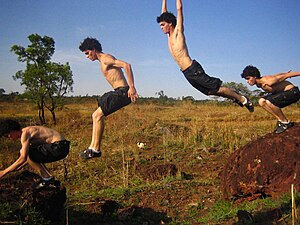Parkour/Basic Moves/Precision Jump
A precision jump is essentially a jump from a one obstacle to another obstacle landing on your two feet. The word "precision" refers to the accuracy needed to land the jump, for example landing on a rail or bollard requires more precision than a large wall or rock.

The jump is usually performed from a stand-still position. Taking off with two legs and landing with two legs. Taking off from one leg (from a run up) is usually referred to as a "running precision".
When landing (either from a two footed or running take off) it is important that you land on the balls of your feet with your feet together and furthermore "stick" the jump meaning you do not fall forwards or backwards off of the obstacle. the larger distance/smaller the object you are landing on, then the better you are progressing.
When landing a precision jump many people stress the importance of the "90° rule" with an argument that if you bend your legs too much and sink down low into a crouched position, your knees can't and will not tolerate the impact, resulting in joint problems.
The 90° rule is a myth as if you are not strong enough to bend your legs more than 90° then you shouldn't be attempting the jump at all. Everyone can squat but not everyone is strong enough to do so when landing from a height. If you feel uncomfortable with a deep squatting motion then do not attempt any drop or precision jump that will force you into this position.
Having a strong and full range of motion in your legs, is vital when training Parkour, if you cannot go past 90° when landing without discomfort or feeling strong, then physical conditioning is needed to increase your capacity to withstand impact in the full range of motion.
Start with small, low level jumps. From this starting point and with regular practice you should get stronger and get more confidence with jumping and landing. This is transferable to other aspects of Parkour.